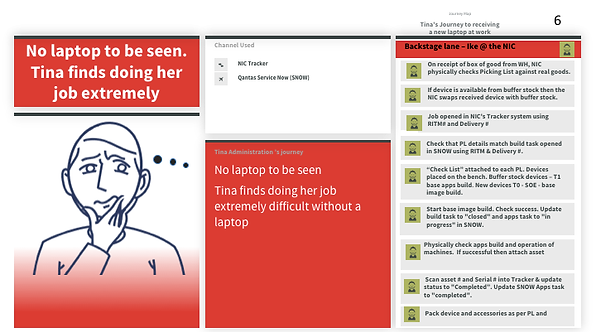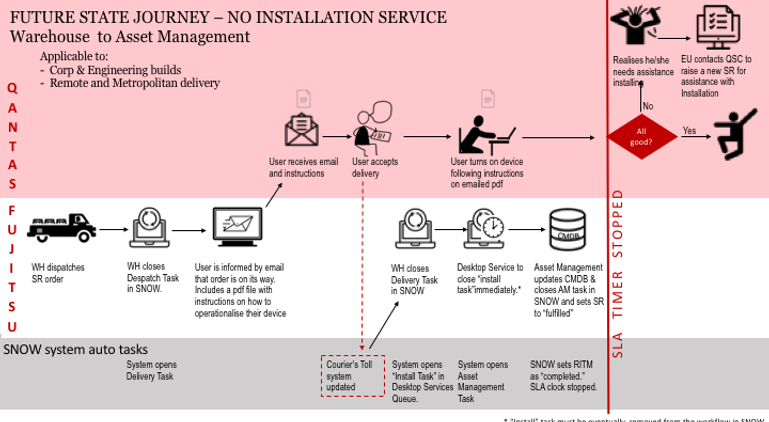
Service design @ fujitsu
for qantas End User Computing
THE ENVIRONMENT
Fujitsu Australia was contracted to provide End User Computing services to Qantas. This included the sourcing, staging and delivery of new and replacement desktops and laptops (devices) to Qantas employees in all international and domestic locations. Qantas employees raised a Service Request for new/replacement devices through the Qantas Service Now(QSNow) portal. From here on the pre-programmed workflow in QSNow will take over, creating a Requested Item (RITM) for that SR, and sequentially opening up tasks in the relevant teams' queue to progress the fulfilment of the SR. Fujitsu's involvement began once the RITM's internal Qantas approval tasks had been completed. The time taken from this point to the delivery of the device to the end-user was contractually set by a SLA.
MY ROLE
As the Evolution Consultant, my role as part of the Fujitsu End User Computing services team onsite at Qantas, was to seek out innovation opportunities that would improve the Qantas end user's experience of Fujitsu services. This involved introducing design thinking capabilities to Fujitsu teams - in particular customer (Qantas) facing teams to help identify areas of opportunity for innovative problem solving.
The first opportunity presented itself when Qantas requested my involvement in looking at how Service Requests (SR) for new/replacement devices could be fulfilled by Fujitsu within the contractual SLA days for domestic locations.
In this project I worked autonomously, assisted from time to time by a new graduate, and keeping my manager updated.
THE PROBLEM
This impacted Qantas employees' ability perform their day to day tasks, causing much frustration. Additionally failure to meet the SLA could invoke heavy penalty fees against Fujitsu.
There was an assumption that the primary cause of the delays was occurring in the NIC

Fujitsu was once again in the process of undertaking a review of both the network and hardware infrastructure with a view to upgrading its capabilities.
In this environment, how might Fujitsu enable fulfilment of its SLA for delivery of devices to domestic locations?
The Service Level Agreement (SLA) between Fujitsu and Qantas, required delivery of devices within 5 days. In reality the the average delivery time was greater than 30 days, extending in some extreme cases to 90 days.
The Network Integration Centre (NIC) was where machines were staged according to the role of the employee it was destined for. These roles were corporate, engineering and airport. The infrastructure of the NIC was old and design inadequate to process the volumes of devices required. As in the past
THE APPROACH
UNDERSTANDING HOW IT ALL WORKED
Methods used for information and insights gathering.
-
Desk research - standing on the shoulders of giants I sought and studied existing reviews. These reports were by engineers who had reviewed the NIC infrastructure and workflows both recently and 3 years prior. I also met and discussed the findings in these reports with the engineers who did the review to get a better understanding.
-
Ethnographic research conducted onsite at the NIC, Warehouse and Desktop Services. The Procurement team was located in Manila and consequently information pertaining to their activities was gathered through studying procedures manuals and phone interviews of staff in Manila.
-
Studying the programmed workflow in QSNow, which mapped out sequentially the tasks to be completed by each team in the fulfilment of the SR.
-
Sampling of SR - In the absence of any reporting tool to extract information regarding the time taken by each team to complete its assigned tasks, we derived this information by sampling 10 randomly selected RITMs and tracking them through the QSNow system. By tracking the date tasks opened and closed in a team's queue, and creating a timeline, we were able to establish where delays occurred in the workflow. Through interviewing relevant staff and analysing the QSNow workflow notes, we were able to also gauge the most common causes for delays.
Some Service Now knowhow to help you
A user wishing to request a service such as "I wanna a new laptop" will raise a Service Request on the SNow portal. This will be converted to a RITM (Requested Item) which carries the workflow requirements for the requested item.
Based on this pre-programmed workflow, tasks are created and assigned to different departments/teams/persons. e.g. In this case there would be a task assigned to the user's manager for approval. On completion of that task, new tasks for that RITM will open in the Fujitsu's Procurement team queue. On completion and closing of these tasks, new tasks for that RITM will open in the Warehouse' queue -triggering a picking list and prompting the release of the laptop from the warehouse. As the warehouse closes this task as completed, tasks will open up for the NIC team to stage the laptop. And so on until finally the Desktop Services team have installed the device on the user's desk and obtained their sign off, at which point Desktop will close the final tasks for that RITM. At this point the RITM itself is closed and considered fulfilled.
ANALYSIS AND VISUALISATION TOOLS
-
I used storyboarding to map the experience journey of a fictitious Qantas employee - Tina and used this to bring onboard Fujitsu teams - creating connection and empathy with the end user.
-
I then mapped the journey of the RITM. Whilst it was unusual to map the journey of a 'thing', this was preferred over a process flow map as it helped to keep the focus on the human element of the process (employee experience) and also lent itself to be embedded together with the experience journey into a Service Blueprint.
-
Service Blueprinting created a connection between the end user's experience at any one point, and the underlying processes and employee experiences occurring at the same point. It also helped to visualise the end to end journey experiences and processes holistically, and highlight opportunities (gaps) for enhancement.

Storyboarding Tina's experience

Extract Journey map of the SR.

Service Blueprint of Tina's journey
INSIGHTS
Disclosure Constraints
Due to the sensitive nature of the issues I am not at liberty to expand on specifics. As such I will focus on process and approach, and not expand on the problem or the details of outcomes.
We now had a clear picture of:
-
The end-to-end workflow and detailed tasks to be completed by each Fujitsu team.
-
The enablers and challenges that faced the staff in each of these teams.
-
Most importantly where in the workflow bottle necks occurred and contributed towards delays in fulfilling an RITM and tagging it as closed.
-
The RITM journey initiated by an appropriately approved Service Request in QSNow journeys through 4 Fujitsu internal teams.
-
Procurement - checked stock levels, specifications and approved RITM for release of goods from warehouse.
-
Warehouse - picked items from warehouse and delivered to NIC.
-
NIC - staged the device in line with the requirements of the role of the Service Requestor
-
Warehouse - received staged device and organised delivery via courier to Service Requestor.
-
Desktop Services - installed device at Requestor's workstation and obtained their sign off.
-
The hypotheses that the NIC was the primary contributor to delays was NOT validated. Instead our results showed that the largest delays occurred in Desktop Services and Procurement in that order, and that the NIC was a mid-level contributor to delays.

PROJECT CHALLENGES
Challenges of the project
-
An intensly siloed structure of Fujitsu.
- Little inter-team collaboration.
- Process oriented as opposed to customer centric mindset.
- Little understanding of the overall journey and how their own operations impact the overall journey or another team's operations.
- Management hostile towards any suggestion to form a team to solve problems collaboratively.
-
Non-collaborative, impulsive, short-term-fix orientated decision making practices leading to overnight changes in processes and systems with no testing or plan for implementation.
-
Focus on producing deliverables rather than achieving a lasting measurable outcome.

MOVING FORWARD
TARGETTING LOW HANGING FRUIT
Given the lack of management support for any type of formal collaborative solution making, and the absence of any apetite for it amongst staff, I resolutely pursued a collaborative approach covertly, informally inviting multi-disciplinary teams to work together to understand each other's challenges and find ways of working that supported each other.
Having identified 3 areas responsible for bottle necks, I separated these into 3 sub-projects. Intent on taking hold of low hanging fruit to deliver quick results where possible but adhering to best practice methods of design, usability testing and an iterative approach.
PROJECT
Desktop Services - No Installation project
PROJECT INFLUENCE
High impact, Low cost, Quick wins
PROJECT ENABLERS & CHALLENGES
-
Supportive , visionary team managers.
-
Obtaining multi-team collaboration and co-operation.
-
Introducing a new mindset to management.
-
Engaging with offshore development team to make changes to SAP system and develop code to enable new functionality.
NIC - Quick wins project
Medium impact, potential for quick wins, high cost in terms of resources
-
Required heavy collaboration and investment by technical staff (software engineers, architects etc.) to help enable this process.
-
I nor the Fujitsu Client Service Director for Qantas had any control over the allocation of these resources to enable this.
-
Obtaining multi-team collaboration and co-operation.
Procurement Catch-up project
High impact, high cost in terms of time and dollar investment.
-
A deep dive into understanding processes and root cause analysis was required, with possibly considerable time spent on-site in Manila where the team was located.
-
High turnover and un-trained staff .
DESKTOP INSTALLATION
Further investigation revealed that personalised installation of a user's device at their workstation was not required under the new contract, however Desktop Services had continued to perform this task. Given their responsibility for attending to incident tickets and time delays in co-ordinating time for installation with end- user, delays in the performance of this task accounted for a considerable portion of the delays in meeting SLA.
Re-designing the end-user experience and processes
The easiest way forward was to simply stop performing this service. However, the impact on end user experience needed to be considered. Using covert methods of collaboration, I prepared future state journey maps and used this tool to explore viability and iterate on the journey with relevant parties from relevant teams.
Implementing the new design
I worked closely with a business analyst familiar with SAP, and off-shore software developers,
- to develop specifications for changes to the SAP system that would enable the new process; and
- to develop code to enable new functionality - eg. trigger emails to the end-user.
As there was a move to self-serve installation, we developed interactive installation guides that users could use to install their own devices. These were tested with users and changed through many iterations.
Outcome
New process in production parallel to old process, with ongoing monitoring to obtain feedback for further iteration.
NIC - QUICK WINS PROJECT
I continued to support the Infrastructure project team in specifying the needs of NIC staff with regards to their employee experience and functionality requirements, acting as the facilitator/translator.
I worked resolutely to make technical resources available to enable changes, by interacting with the management of technical teams. eg.
- provision of off-line methods to perform staging, in light of network crashes that delayed staging activities,
- clean up of SOE code to improve efficiency and reduce network download times .
PERSONAL LEARNINGS FROM PROJECT
-
Service Now and its use in an ITSM environment
-
Covert application of Design Thinking approach
-
IT Technical lingo and processes
-
Interacting with IT technical (software engineers & architects, developers etc.) and IT delivery staff (SDMs)
More Portfolio Items
. . . .



